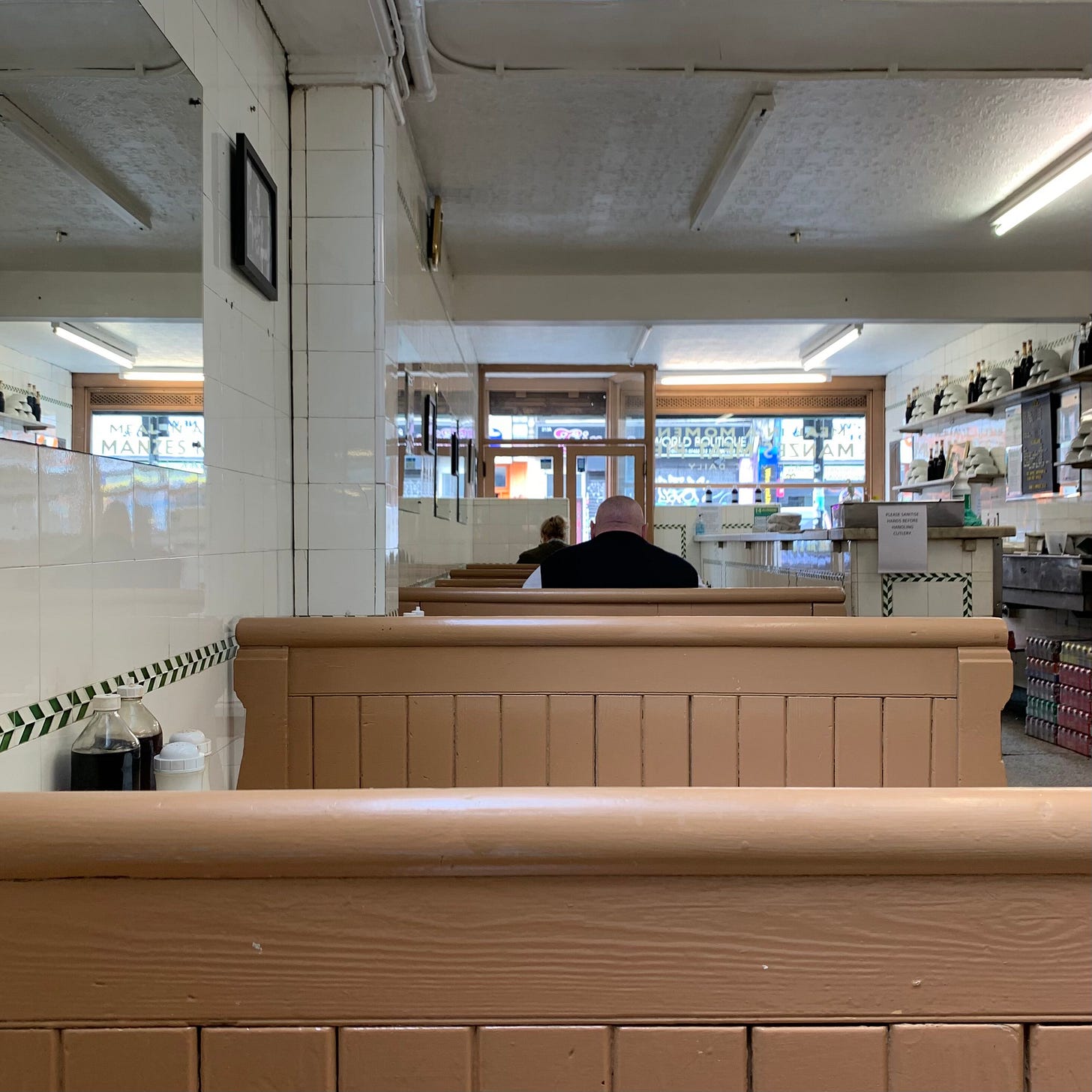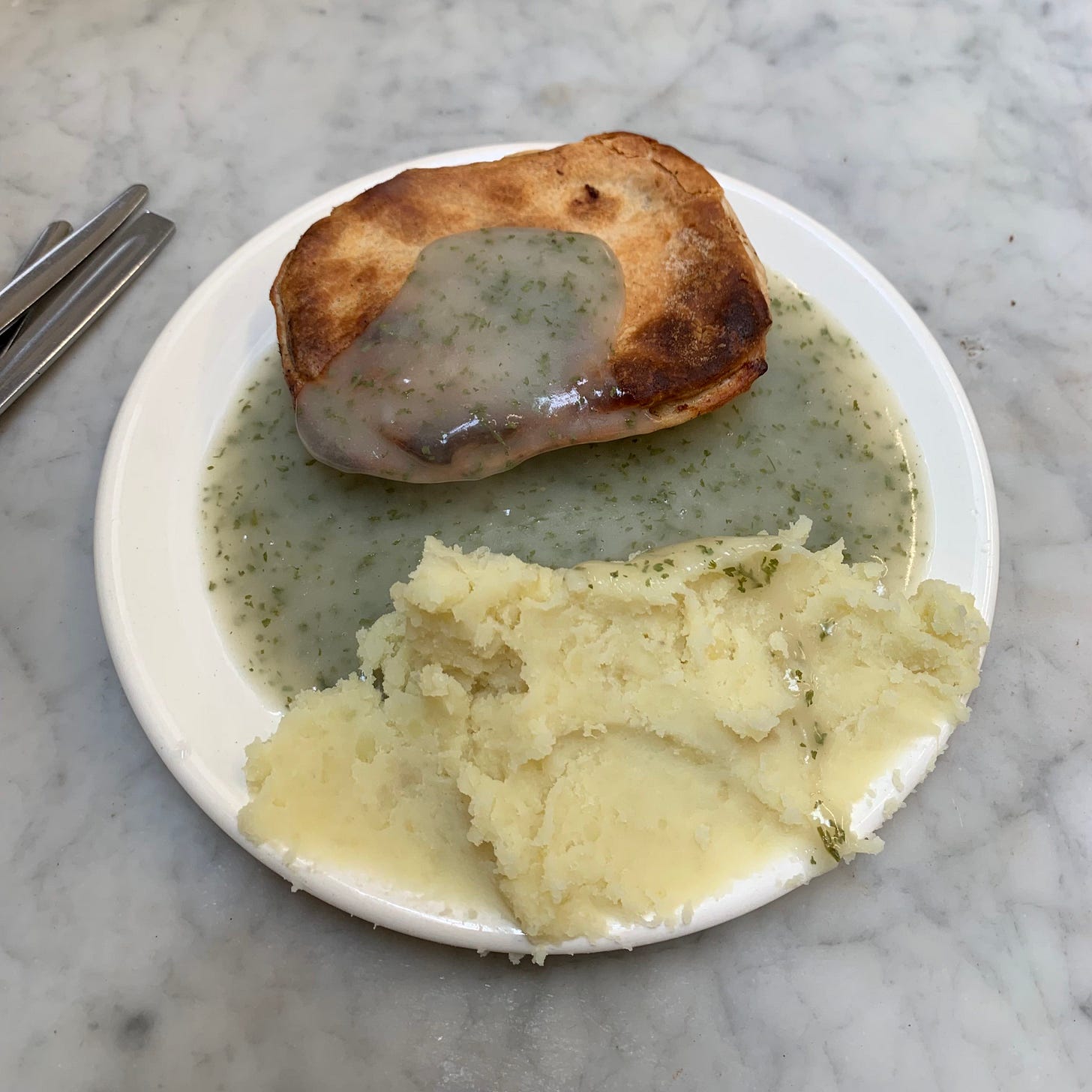Hello and welcome to Wooden City, a newsletter about London.
If you haven’t come here via @caffs_not_cafes, I'm a writer called Isaac Rangaswami and this is my Substack.
Every other week I publish an article about everyday places in London with unusual staying power, like shops, buildings, restaurants and public spaces.
Wooden City is a reader-supported publication and paid subscribers get much more. This includes access to maps, full articles and an archive of material covering over 125 places so far.
When I first started eating out alone, I’d always try to spend less than a fiver. This was back in 2019 – and I was mostly eating in caffs – so it wasn’t that hard. These days it isn’t unusual for fry-ups to exceed £10 in London, even in more straightforward spots. Like other price rises, I once resented this, but now I’m used to it.
Caffs weren’t the cheapest places to eat in the city anyway. Aside from making one yourself, the most affordable meal in London is probably still a box of fried chicken with chips. This is followed closely by a refrigerated sandwich with crisps and a drink, or another approved combination of items. Although they have also become more expensive, you can still get a basic supermarket meal deal for around £3.50.
The other obvious places, such as Greggs and McDonald’s, offer deals around this price too. But the coffee chains can’t claim affordability anymore. They are ubiquitous but their food is not cheap, dotted around like tourist traps for people who aren’t on holiday.
As far as I can tell, it took at least 44 years to get where we are now. Back when M&S pioneered the packaged sandwich in 1980, the UK “was a land of formica counters, fluorescent lighting and lunches under gravy,” as Sam Knight writes. I’m sure eating out was much the same five years later, when a Sri Lankan man opened London's first Morley’s. And to some extent in 1995, when Costa only had 39 outlets.
I don’t want to suggest that British life during this Ceefax, Bakerloo brown era was perfect. But it was a time when students living in squats could eat in Soho for pocket change. I arrived in London after this dream had ended, but I still try to keep it alive by eating in Wong Kei for £8.90 as often as I can. And you can still eat good food for even less than that, especially in outer London. A lot of the time this means things like soups, stews, chaats, curries, sandwiches and other bread and wrap-related meals. Often, it simply means a smaller portion.
Places that serve filling meals for around £5 are far rarer, especially those that centre around eating in. So recently I’ve been going back to five spots that fit this criteria, where the most expensive, least expensive offering that constitutes something close to a full meal is £5.30. I’ve chosen these places not just because they have a community function, but also because they sit near areas where both locals and people coming from further afield tend to mix, like high streets and markets. As before, my goal has been to paint a standalone portrait of each restaurant. And by placing them side by side, I hope to draw attention to what they have in common.
Manze's
Throughout much of its life, pie and mash meant inexpensive food. Then other affordable dishes came along, undercutting its cheapness. More recently, its ingredients became more expensive, as did turning the lights and the oven on.
At Manze’s on Deptford High Street, one pie and one mash currently costs £5.30, which seems like a fair price to me. Next year, Manze’s will close. Not because of landlords, developers or changing tastes, but because its owner is going to retire. “It’s always been the plan,” I overheard him tell a customer the last time I was there. “I’m looking forward to retiring, I'm not gonna lie about that,” he told Southwark News in January.
As a building, Manze’s will endure, because it was recently granted listed status. I’m glad it won’t be destroyed, but I think it’ll be weird if it becomes a glasses shop, like F. Cooke on Broadway Market.
I didn’t grow up eating this dish, so I don’t have a licence to get dewy-eyed about it. But I like pie and mash and I’ve eaten it in 12 different places so far. I rarely notice much variation between them, but the meat filling at Manze’s has a texture I prefer to some of the others. It’s packed tightly like a meatloaf, and less granular.
Manze’s dining room is ornate in the way restaurants from previous eras are, and beautifully primitive for the same reason. It has dramatic ceilings, marble tables and benches with seats that don’t go very far back, here painted the colour of pale sand. The wrought iron that props them up swirls like the tendrils of a climbing plant, and the cracks in its stone floor speak to the place’s age, as if a small tremor once happened beneath its surface.
While there can be a queue on Saturdays, Manze’s has been calm and languid on the weekday afternoons I’ve been. On those occasions I’ve shared the room with a couple of other customers, at least one of them chatting with whoever’s behind the counter. I usually get a cup of tea with my meal, which you sometimes make yourself. Last time the owner kindly made mine and asked me if there was enough milk in it before handing me the mug.
204 Deptford High St, London SE8 3PR




